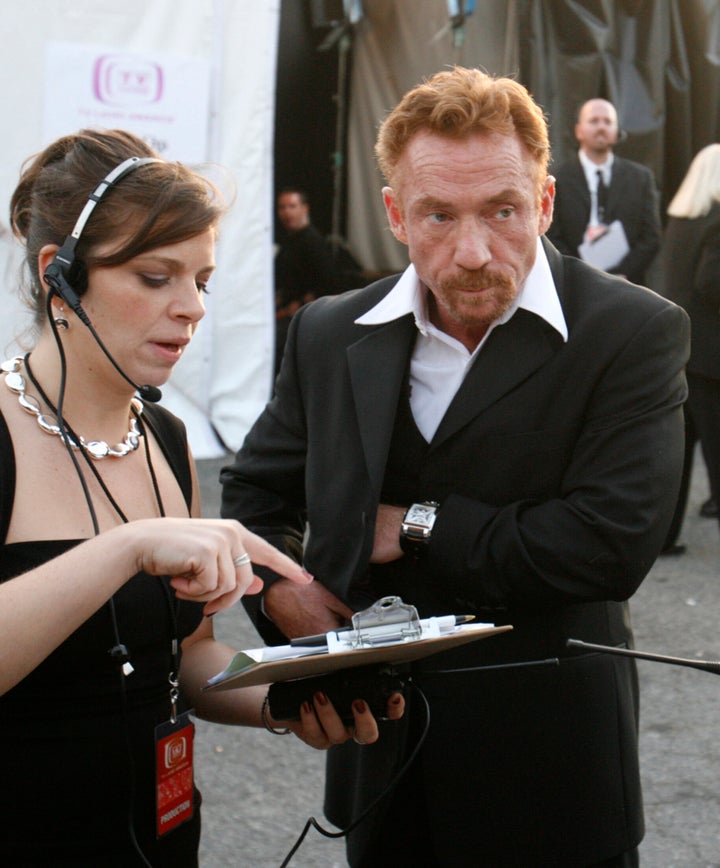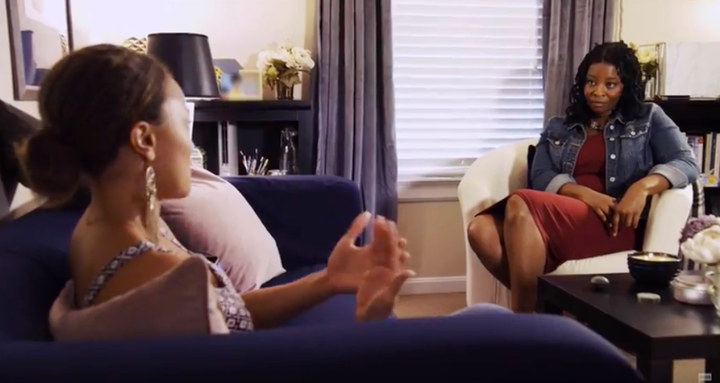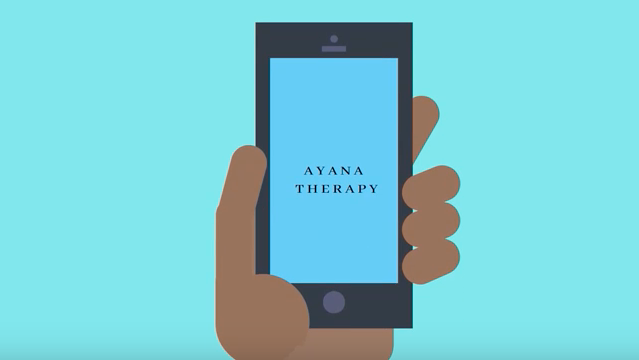Quietly, discreetly, more and more reality shows have been showing stars regularly attending therapy. But unlike earlier iterations of therapy on TV, these sessions feel like a normal part of life, like going to meet your girlfriend for lunch at, say, SUR to work through your relationship drama. And with a recent American Psychological Association poll showing that nearly half of respondents say the stigma toward seeking mental health services has decreased in recent years, it’s no surprise therapy on reality TV has become a more accepted, normal part of a show.

Jamie Otis, one of the success stories of A&E’s “Married At First Sight,” will proudly attest to that. Otis sat through couples counseling and therapy during that show as well as the spinoff “Married At First Sight: The First Year.”
“I mean, everyone knew 10, 20 years ago, therapy had such a stigma to it. That means you’re flawed,” Otis said. “Now, people are able to come out a bit more and share their stories.”
According to Otis, reality TV shows might not have set out to destigmatize therapy, but that has certainly been one result ― even if the road was bumpy getting there.
The Problem With Therapy In Early Reality TV
Therapy looked a lot different on reality TV even just a decade ago. Many shows that featured therapy or therapists in the late ’90s and early 2000s often involved Drew Pinsky ― better known as Dr. Drew ― a celebrity doctor and addiction specialist. ”Big Brother,” for example, was one of the first reality shows to employ a therapist regularly. The program used Pinsky in its earlier seasons, although he only observed contestants rather than interacted with them in typical sessions. “Survivor” also had psychologists around for consultations as early as its first season.

As time went on, mental health professionals started appearing in front of the camera instead of behind it. But as more shows started experimenting with featuring therapy in their episodes, the sessions were used more as a plot device and often felt inauthentic or casuistic.
In VH1’s 2005 show “Breaking Bonaduce,” the series uses a couples therapy session with former child star Danny Bonaduce and his wife Gretchen to introduce Danny as someone who is cheating, damaged and has an addictive personality; by the end of the series, Gretchen has filed for divorce. Therapy was a conduit to discuss drama and did nothing to heal the person or the relationship. At the time, many critiqued the program for standing by and filming Danny when he drank and drove, boasting that a crash would make “great television.”
“There’s lots of ways that reality TV kind of gives itself a bad name. I mean, they really have done some terrible things in the past to really exploit people for the benefit of getting a good rating.”
– Kerrie Mohr, psychotherapist
During this time, therapy on reality TV also mostly centered around airing reality stars’ issues for public entertainment. In VH1’s “Celebrity Rehab with Dr. Drew,” which premiered in 2008, famous and fallen actors were treated for substance use issues at a recovery center. According to a 2008 New York Times review, the show made “its fortune from other people’s misfortune.” The review also described the show as “a last call for show business has-beens who crave one more crack at fame and will allow cameras into their treatment center bathrooms and therapy sessions for the opportunity.”
This type of portrayal is exactly what worried experts when therapy became more heavily featured on reality TV. The audience can easily get the impression that therapy and mental health issues not only damage a person’s life forever, but they’re explosive and dramatic.
“[Some early reality shows] seemed to be set up in a way that shows the high-level, dramatic scenarios with a lot of reactivity and interpersonal conflict,” said Christine Moutier, the chief medical officer for the American Foundation for Suicide Prevention. “I worry that gets conflated with mental health conditions because those scenes can be just issues of circumstance or maturity level, having nothing to do with something like depression or bipolar disorder.”
Because of therapy’s past on TV, many in the profession also fear that filmed sessions could be inaccurately or unethically produced. Kerrie Mohr, a practicing psychotherapist in New York and a therapist on Bravo’s “Summer House,” says she got pushback from colleagues when she agreed to air her sessions with “Summer House” star Lindsay Hubbard on television.
“There’s lots of ways that reality TV kind of gives itself a bad name. I mean, they really have done some terrible things in the past to really exploit people for the benefit of getting a good rating,” Mohr said.

So what has changed since then? Soap-opera-style shows like “The Real Housewives,” began following their subjects in a more documentary style. That led to therapy being featured more as something that’s part of one person’s life.
“The Real Housewives of New York” star Bethenny Frankel, for example, began seeing her therapist Xavier Amador regularly in Season 7. Throughout the season, Frankel was raw and vulnerable as she sifted through various stressors, including divorce and career disappointments. In the show, Frankel also talked in therapy about reconnecting with her estranged father. She showed her sessions with a licensed professional, implicitly showing viewers the benefits of working through feelings with a therapist.
Therapy was shown as it really is for most Americans: a place where someone can discuss past and present issues that affect day-to-day life — and not as a one-time fix, but as a regular part of everyday life. More documentary-style shows, like Bravo’s “Summer House” and “Vanderpump Rules,” attempted to do the same.
Scenes like these can be beneficial because they portray therapy “in a remarkably nuanced, realistic and helpful way,” Moutier said. “They show what it looks like and that it’s not a quick fix; that therapy is generally a positive experience.”
What Filmed Sessions Are Really Like
Of course, a filmed therapy session will never directly mimic the confidentiality of normal therapy sessions. But surprisingly, the scenes you see in shows like “Summer House” or “The Real Housewives” can largely be reflective of what the process is like for non-reality stars, with only a few minor differences.
“The producers, they make themselves almost invisible,” Mohr said of her time filming on “Summer House.” “That said, in a typical session, you don’t tend to have eight people videotaping and watching you. But as far as how it’s actually portrayed, it’s pretty accurate.”
Hubbard, Mohr’s client and a star of the show, agreed. “When I’m being filmed at one of my therapy sessions, it’s the one time that they let me just talk to my therapist about the things that I need to talk about. I’ve gotten used to the cameras; it’s not hard to forget that they’re there,” she said.
The main difference between regular sessions and those on reality TV is the set-up time required for shooting the session. But once the therapy session begins, producers are largely hands-off, allowing the session to develop as naturally as possible, Hubbard added.
According to Mohr, when people watch these types of reality shows, they see characters “being open and honest about their struggles, and really relying on a therapist to work through those things.” As a result, viewers can “see that they’re not alone with what it is that they’re dealing with,” she said.

Esther Boykin, a therapist on “The Real Housewives of Potomac,” admitted that when she started doing sessions for the show, she was concerned the cameras would shift the overall tone of the therapy session, making the client more quiet or performative. However, these concerns would also be relevant and useful for a therapy session, since clients who change in front of the camera also adopt similar strategies in other areas of life. In Boykin’s experience, the emotion that ended up on camera was genuine.
Boykin wants to positively affect the audience’s view of therapy. “My biggest hope for people watching therapy sessions on TV is that it feels less scary. I always hope that people will see it and be like, ‘Oh, I could do that,’ or, ‘Oh, that person is talking about something that I can relate to. Maybe I should try this experience, too.’”
“The Real Housewives of Atlanta” star Candiace Dillard, who spent several episodes going to therapy with her mother, has gotten positive responses to the show’s portrayal of her struggles. “We are moving into a space in society where going to therapy and talking about your feelings and being open about your feelings, especially amongst the millennial generation, it’s less taboo,” Dillard said.
Diverse Representation Of Mental Health On TV
Considering that minorities receive mental health treatment at significantly lower rates than white people, Boykin agreed to have her therapy sessions with star Ashley Darby filmed because “it was important to see her going to see a licensed therapist as a woman who was also a person of color.”
Normalizing therapy is especially crucial in communities where therapy’s stigma is greater, such as among men or Black people.

“Women of color do, in fact, go to therapy … it doesn’t always have to be a major crisis that prompts them to do that and to be kind of an example of what it’s like to have a therapist rather than getting advice from a nonlicensed professional or just girlfriends,” Boykin said.
Shows like “The Real Housewives of Atlanta” and “The Real Housewives of Potomac” speak directly to the lives of Black women moving through their everyday lives, which can include therapy. Dillard believes the benefits of showing sessions can be immense, since there “has been sort of a slower, more gradual case for the Black community in coming to terms with, OK, this is a thing, we can name it and we can be OK with it in our community.”
For people who think that there’s no social benefit to reality TV, Boykin believes is it a disservice to dismiss the fact that people are willing to share their stories.
“People who are watching these shows who can relate to the storylines, who relate to having difficulties as an adult, having difficulties with their mother, or who have struggles with their husband or have trouble conceiving — understand that watching people has value, it helps people to feel less alone,” Boykin said.
“My biggest hope for people watching therapy sessions on TV is that it feels less scary. I always hope that people will see it and be like, ‘Oh, I could do that.’”
– Esther Boykin, therapist on “The Real Housewives of Potomac”
Being On TV Can Further Complicate Mental Health
Not all reality TV shows strive for a realistic representation of therapy sessions. Reality TV is not everyone’s cup of tea, and for some in the mental health profession, there’s a good reason for that.
Following the deaths of “Love Island” stars Mike Thalassitis and Sophie Gradon, The Sun reported earlier this year that nearly 40 reality contestants may have died from suicide since 1986. Emma Kenny, a psychologist who has worked on the U.K.’s version of “Big Brother,” told The Sun that she isn’t surprised, given how filming a reality show can take a gruesome toll on a person’s well-being. “These figures are horrendous,” Kenny said. “I have seen people broken after reality TV.”
Hubbard would be the first to admit that the pressures of reality TV can complicate mental health. She said she sees therapy as a necessity, partly because of the hectic filming schedule and the pressure of having her life exposed to millions of people. “There’s irony there,” Hubbard said. “I go to therapy because I get stressed out having two full-time jobs, one of them being filming, but at the same time, my TV show is helping normalize therapy.”
“Maybe it’s a secret plan,” she laughed. “We’re going to normalize therapy, so we’re going to stress Lindsay out so that she has to go to therapy, and then we can show that.”
With therapy, Dillard recommended going “once a month to do a check-up, like you go to the doctor once a year for an annual.”
“It’s the same thing,” she said. “Your mind is a muscle. It needs to be massaged and checked up to date with the latest and greatest technologies.”
Normalized But Not Yet Accessible
Encouraging people to seek mental health help is only one part of the battle. There’s still a major access problem when it comes to therapy. There are a lot of barriers to treatment, including difficulty finding access in rural areas.
For many, finding therapists covered by insurance (if you’re even lucky enough to have insurance) is a daunting task and a massive financial undertaking. The average cost of therapy in New York is $200 to $300 per session, according to one report.

In today’s smartphone-centered era, there are other options. Apps like Talkspace and Better Help allow users to text with licensed counselors for a small fee. For underserved or minority populations, Boykin pointed out that there are specialized sources of information like Therapy For Black Girls or Ayana Therapy, which helps minority and LGBTQ clients get matched with therapists.
Recent reality TV shows may have only played a small part in the overall normalization of therapy, but it’s part of a greater pop culture movement. Celebrities have also been more vocal about their willingness to seek help; therapy memes are getting thousands of retweets. People aren’t just seeing therapy as a place to go when you’re in crisis or your life is a disaster. Moutier said that any form of mass entertainment that properly portrays the process is welcomed by experts.
“I think it can debunk a lot of myths and help people understand that mental health is part of your overall health,” Moutier said.
And, bottom line, reality TV has a lot of influence. If it encourages even just one person to make their mental health a priority, it’s a win. Otis said that sharing your struggles with a professional can be immeasurably helpful.
“When you hide it and you hold it inside, you’re so weighed down by it that it really does still affect you. I mean, I still sit here and think about it and get teary-eyed, and it’s like, ‘Man, if I could talk about that more.’ If you can just spend the time to work through this problem, the weight is off your chest and you’re so much happier.”
Credit: Source link